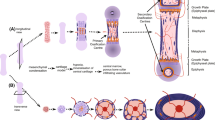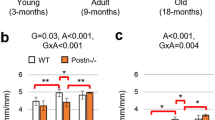Abstract
Rat tibial growth plates have X-ray opaque tethers that link the epiphysis and metaphysis and increase with age as the growth plate (GP) becomes thinner. To determine if tether formation is a regulated process of GP maturation, we tested the hypotheses that tether properties and distribution can be quantified by micro-computed tomography (microCT), that rachitic GPs typical of vitamin D receptor knockout (VDR−/−) mice have fewer tethers and altered tether distribution, and that tether formation is regulated by signaling via the VDR. Distal femoral GPs from VDR+/+ and VDR−/− 8-week-old mice were analyzed with microCT and then processed for decalcified and undecalcified histomorphometry. A wide range of parameters that assessed GP and tether geometry and morphology, along with tether distribution, were measured using both microCT and histology. Growth plates of 10-week-old VDR+/+ and VDR−/− mice on a high-calcium, phosphorus, lactose, and vitamin D3 rescue diet were also analyzed. Both microCT and histology showed tethers present throughout normal mice GPs, while reduction in tether number and volume percentage occurred in VDR−/− GPs with localization to the central region. Decreased shrinkage in the axial direction during decalcified histological processing correlated with tether formation, suggesting mechanical stability due to tethers. Tether formation increased greatly between 8 and 10 weeks. Rescue diets restored VDR−/− GP size but not tether volume percentage. Overall, these results demonstrate microCT imaging’s utility for analyzing tether formation and suggest that signaling via the VDR plays a pivotal role in tether formation.







Similar content being viewed by others
References
Boyan BD, Schwartz Z, Howell DS, Naski M, Ranly DM, Sylvia VL, Dean DD (2001) The biology, chemistry, and biochemistry of the mammalian growth plate. In: Coe FL, Favus MJ (eds) Disorders of bone and mineral metabolism. Lippincott, Williams, and Wilkins, Philadelphia, pp 498–532
Chen CH, Sakai Y, Demay MB (2001) Targeting expression of the human vitamin D receptor to the keratinocytes of vitamin D receptor null mice prevents alopecia. Endocrinology 142:5386–5389
Kato S (1999) Genetic mutation in the human 25-hydroxyvitamin D3 1α-hydroxylase gene causes vitamin D-dependent rickets type I. Mol Cell Endocrinol 156:7–12
Li YC, Amling M, Pirro AE, Priemel M, Meuse J, Baron R, Delling G, Demay MB (1998) Normalization of mineral ion homeostasis by dietary means prevents hyperparathyroidism, rickets, and osteomalacia, but not alopecia in vitamin D receptor-ablated mice. Endocrinology 139:4391–4396
Amling M, Priemel M, Holzmann T, Chapin K, Rueger JM, Baron R, Demay MB (1999) Rescue of the skeletal phenotype of vitamin D receptor-ablated mice in the setting of normal mineral ion homeostasis: formal histomorphometric and biomechanical analyses. Endocrinology 140:4982–4987
DeLuca HF (1985) The metabolism and functions of vitamin D. In: Norman AW, Schaefer K, Grigoleit HG, Herrath DV (eds) Vitamin D: chemical, biochemical and clinical update. Walter de Gruyter, New York, pp 361–375
Boyan BD, Dean DD, Sylvia VL, Schwartz Z (1998) Role of vitamin D: genomic and nongenomic regulation of cartilage by 1, 25-(OH)2D3 and 24, 25-(OH)2D3. In: Buckwalter JA, Ehrlich MG, Sandell LJ, Trippel SB (eds) Skeletal growth and development: clinical issues and basic science advances. American Academy of Orthopaedic Surgeons, Chicago, pp 333–359
Boyan BD, Schwartz Z (2005) Cartilage and vitamin D: genomic and nongenomic regulation by 1, 25(OH)2D3. In: Feldman D, Pike JW, Glorieux FH (eds) Vitamin D, 2nd edn. Elsevier Academic Press, Burlington, MA, pp 575–597
Martin EA, Ritman EL, Turner RT (2003) Time course of epiphyseal growth plate fusion in rat tibiae. Bone 32:261–267
Haines RW (1975) The histology of epiphyseal union in mammals. J Anat 120:1–25
Rogers LF, Poznanski AK (1994) Imaging of epiphyseal injuries. Radiology 191:297–308
Sailhan F, Chotel F, Guibal AL, Gollogly S, Adam P, Berard J, Guibaud L (2004) Three-dimensional MR imaging in the assessment of physeal growth arrest. Eur Radiol 14:1600–1608
Reich A, Sharir A, Zelzer E, Hacker L, Monsonego-Ornan E, Shahar R (2008) The effect of weight loading and subsequent release from loading on the postnatal skeleton. Bone 43:766–774
Sergerie K, Lacoursière MO, Lévesque M, Villemure I (2009) Mechanical properties of the porcine growth plate and its three zones from unconfined compression tests. J Biomech 42:510–516
Villemure I, Cloutier L, Matyas JR, Duncan NA (2007) Non-uniform strain distribution within rat cartilaginous growth plate under uniaxial compression. J Biomech 40:149–156
Li YC, Pirro AE, Amling M, Delling G, Baron R, Bronson R, Demay MB (1997) Targeted ablation of the vitamin D receptor: an animal model of vitamin D-dependent rickets type II with alopecia. Proc Natl Acad Sci USA 94:9831–9835
Donohue MM, Demay MB (2002) Rickets in VDR null mice is secondary to decreased apoptosis of hypertrophic chondrocytes. Endocrinology 143:3691–3694
Boyan BD, Sylvia VL, McKinney N, Schwartz Z (2003) Membrane actions of vitamin D metabolites 1α, 25(OH)2D3 and 24R, 25(OH)2D3 are retained in growth plate cartilage cells from vitamin D receptor knockout mice. J Cell Biochem 90:1207–1223
Zar JH (1984) Biostatistical analysis, 2nd edn. Prentice-Hall, Englewood Cliffs, NJ
Nemere I, Farach-Carson MC, Rohe B, Sterling TM, Norman AW, Boyan BD, Safford SE (2004) Ribozyme knockdown functionally links a 1, 25(OH)2D3 membrane binding protein (1, 25D3-MARRS) and phosphate uptake in intestinal cells. Proc Natl Acad Sci USA 101:7392–7397
Nemere I, Schwartz Z, Pedrozo H, Sylvia VL, Dean DD, Boyan BD (1998) Identification of a membrane receptor for 1, 25-dihydroxyvitamin D3 which mediates rapid activation of protein kinase C. J Bone Miner Res 13:1353–1359
Dardenne O, Prud’homme J, Hacking SA, Glorieux FH, St-Arnaud R (2003) Correction of the abnormal mineral ion homeostasis with a high-calcium, high-phosphorus, high-lactose diet rescues the PDDR phenotype of mice deficient for the 25-hydroxyvitamin D-1α-hydroxylase (CYP27B1). Bone 32:332–340
Aszódi A, Hunziker EB, Olsen BR, Fässler R (2001) The role of collagen II and cartilage fibril-associated molecules in skeletal development. Osteoarthr Cartil Suppl A:S150–S159
Acknowledgments
The authors thank Brandon Gray and Ayanna Miller for their help in developing the mouse growth plate tether map. This research was supported by grants from Children’s Healthcare of Atlanta and the Georgia Tech/Emory Center for the Engineering of Living Tissues (NSF EEC 9731643) as well as a National Science Foundation Graduate Research Fellowship (to C. S. D. L.).
Author information
Authors and Affiliations
Corresponding author
Rights and permissions
About this article
Cite this article
Chen, J., Lee, C.S.D., Coleman, R.M. et al. Formation of Tethers Linking the Epiphysis and Metaphysis Is Regulated by Vitamin D Receptor-Mediated Signaling. Calcif Tissue Int 85, 134–145 (2009). https://doi.org/10.1007/s00223-009-9259-1
Received:
Accepted:
Published:
Issue Date:
DOI: https://doi.org/10.1007/s00223-009-9259-1




